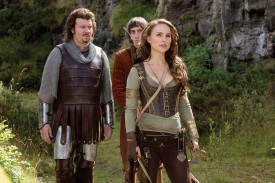
He would not have been the first person to try to save a bad movie with T&A.
Take the puerile 2011 “comedy” Your Highness. Already steeped in misogyny – the villain plans to rape Zooey Deschanel so that she’ll conceive some kind of demon, a plan which the script treats as more comedic than abhorrent – the film reduces Natalie Portman’s warrior to eye candy with a needless thong scene. Inevitably this scene figures prominently in the trailer.

Or 2009’s Whiteout, starring Kate Beckinsale as a US Marshall stationed at a research base in Antarctica. How is her character introduced? Setting up her deductive powers as she solves a case? Establishing her authority as she defuses a tense situation? Demonstrating her physical prowess as she chases down a suspect? No. She strips off and takes a shower, and the camera gets a close-up of her bum. For no reason whatsoever. Whiteout is immediately ruined because the audience has been told that the lead character is only there to be ogled. Presumably director Dominic Sena misguidedly thought that a little skin would improve the appeal of a film that’s uniformly inept, from the production design – a British character decorating his room with a huge Union Jack, seriously? – to the script, revealing its tedious backstory through clumsy flashbacks. (Even more depressingly, I’ve just read on Wikipedia that the graphic novel the film is based on had two female leads, but one was changed to a man for the film because the studio thought that would increase the audience.)
There are of course many, many more examples both in cinema – like the inexplicable Alice Eve underwear shot in Star Trek Into Darkness – and in the wider media, as evidenced by this brief but telling montage.
There will be some men reading who think gratuitous female nudity is harmless, even a good thing, but here are just a few reasons why it’s not:
- It’s a signpost that your film is bad, and you know it is.
- It undermines your female characters, weakening your story and the level of emotional engagement an audience will give to it.
- Your actress is a human being. How does she feel about it? What about the countless websites that will inevitably take the scene out of context and present it for male gratification?
- It perpetuates the objectification of women and misogyny in general, both huge problems in our culture today.
- It contributes, I strongly suspect, to the dearth of women behind the camera, by portraying them as glorified props rather than valuable contributors to the filmmaking process.
If writers spent more time on crafting good characters, particularly good female characters, they wouldn’t need gratuitous T&A or any other spurious fixes. Stronger female characters are starting to appear in cinemas, but often they’re far from ideal. This article from Dissolve questions the quality of some of the superficially strong female characters in recent blockbusters. Putting a woman in an action role just so she can wear a skin-tight costume and demonstrate her physical flexibility is not equality. There’s a long way to go yet.
Joss Whedon, creator of Buffy the Vampire Slayer and director of the Avengers movies, has some excellent and impassioned stuff to say on this subject. I’ll leave him with the closing words.